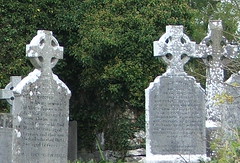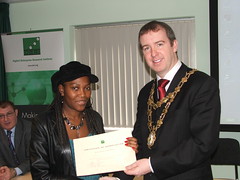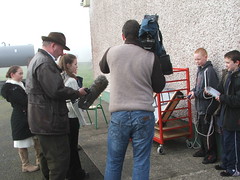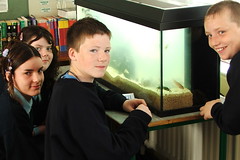Yesterday I helped bury the aunt of my wife Cepta.
For me Kathleen's funeral, though a sad occasion, was strangely enough a very invigorating and illuminating one. It demonstrated what was best in an Ireland that is fast disappearing as it becomes engulfed by a tidal wave of rapid social change.
The funeral took place in a little parish church near the village of Monivea in east Galway.
Kathleen was a very lovely person full of wit and charm. But she was still just an ordinary person with no political or economic clout. Yet her death was seen as a loss, not just for her blood relatives, but for the whole community for miles around. Friends, neighbours and cousins( many of whom who had travelled from all over Ireland) gathered together at the little church to give due recognition to the passing of one of their own.
It was truely touching. 5 priests officiated at the mass.
The night before, her body was laid out in an open coffin and, as is the custom in rural Ireland, locally-based government ministers and politicians came to pay their final respects.
In no other developed country that I know off, nor in fast growing urban Ireland, is this tradition in existence. Since independance, attendance at funerals is a critical aspect of the life of country politicians- it is high up in on their 'must-do' priorities. This shaking of many mourners' hands might be sneered at by some as pure political opportunism. It is probably so in many cases. But it is still uniquely Irish (& 'nice'!) that these high-powered people feel it is important to be there with individual constituents when personal tragedy calls. It gives ordinary families a sense of importance and of belonging.
The Mass had many other quintessentially Irish features- the presence of so many priests; the procession of simple gifts that symbolised the life of the deceased (a garden plant, home-baked bread); the heartfelt eulogy (by cepta), the responsorial psalm readings by the child relatives; the singing of traditional heart-rendering hymns; the cortege led by bouquet bearers and family members; the mourners dressed in black; the throwing of clay onto the coffin as it was lowered into the grave accompanied by the prayer with the immortal words "....from dust though came...to dust though shall return..."; the dinner that followed where all attendees relaxed, unwinded and promised (more in hope than in expectation) that '...Yes, we must get together real soon..."!
My Writings (I hope!) reflect my Guiding Principles: -'Enjoy Life to the Utmost but not at other people's expense'-'Think Global, Act Local'-'Variety is the Spice of Life'-'Use Technology & Wisdom to Make the World A Better Place for All God's Creatures'-'Do Not Accept Injustice No Matter Where You Find It'-'Laughter is the Best Medicine'
Mayor presents Awards to
Our African Asylum Seekers'
Course Participants!
Our African Asylum Seekers'
Course Participants!
(Photo shows Lord Mayor of Galway City presenting certificate to Emma Chuwa (South Africa). Jim Swanick of the 'Galway Centre for Independent Living' is in the background)
Just prior to Christmas, certificates were presented to African asylum-seekers by Lord Mayor of Galway City, Councillor Brian Walsh, for completing DERI's course on 'Online Social Networking'.
8 students from the Eglinton hostel for asylum seekers in Salthill formed the first group to participate in the course which was held in the excellent computer suite of the 'Galway Centre for Independent Living'.
The reception for the adult students took place in Galway University and was well attended by local politicians, community groups and university personnel. We also had a representative (the self-styled 'romeo' Denisson Gomes!) present from the Brazilian community in Gort where we are also organising evening classes in the local school.
An excellent article and photograph appeared in the Irish Times, Ireland's most reputable daily newspaper, on our Institute's Internet-based educational activities with social disadvantaged groups and communities.
My colleague, Ina O'Murchu, thrilled the Africans present when she informed them of the next stage of the course- 'online telephoning' (via SKYPE)
I acted as course organiser in my capacity as DERI Community/Education Officer
Irish Television Crew Filming Children Making Movie Documentary!
We all want to be celebrities! So when my old friend Leo Enright, of radio and TV fame, offered to undertake a series of interviews for Irish television with local school children on their Fionn science projects, I jumped at the chance! Because the young 'uns and their personal entourages (teachers, parents, neighbours...) would really enjoy their 'ten minutes of national fame' and be a great morale booster for little country schools.
The end result was that Leo visited two schools that featured on RTE news programmes a few weeks ago.
One school- Letterfrack in Connemara- gave viewers an overview of their marine projects.
The other television piece followed a group of pupils from Killeeneen National School as they travelled to Carnaun near Athenry to film and interview their counterparts on their Solar Energy project.
It made fascinating tv as we watched a children's movie documentary in the making!
Credit most go not just to Leo Enright for making this unique event happen but also to Bernard Kirk of the Galway Education Centre for his critical input
The end result was that Leo visited two schools that featured on RTE news programmes a few weeks ago.
One school- Letterfrack in Connemara- gave viewers an overview of their marine projects.
The other television piece followed a group of pupils from Killeeneen National School as they travelled to Carnaun near Athenry to film and interview their counterparts on their Solar Energy project.
It made fascinating tv as we watched a children's movie documentary in the making!
Credit most go not just to Leo Enright for making this unique event happen but also to Bernard Kirk of the Galway Education Centre for his critical input
Marine Aquarium in a School Classroom, Connemara
One of the most interesting projects within Fionn was what I called 'Galway Bay in the Classroom'. With funding from the ever-supportive Marie Mannion of Galway County Council's Heritage Office and the expertise of Ireland's National Aquarium, (Atlantaquaria), I had aquariums installed in six Galway schools.
But these were not your usual 'run-of-the-mill' fresh-water tropical fish tanks. Rather the units were populated by a cross section of the marine life that inhabits Galway Bay.
The project allowed children to see at first hand a complete marine world within the confines of their classroom. We wanted pupils to develop an increased awareness of their own local marine heritage through observing how different marine species interact with each other and with their surrounding environment. They gradually learnt that each animal type has an important part to play in maintaining an eco-system. For instance, they could understand the role of crabs in cleaning up the waste produced from other creatures and the camouflage effects that some fish use to avoid detection by their prey and so keep their species from becoming extinct.
Furthermore, the children had themselves to interact with the tank carrying out specific tasks regularly e.g. - changing 20% of the sea-water every 3 weeks; feeding the creatures daily as well as monitoring their progress
Everyone associated with the project came to appreciate the amazing diverse range of wildlife that exists right beside us in the waters of Galway Bay including mullets, wrasse, butter fish, hermit crab, shore crab and starfish. These marine animals became wonderful additions to Galway school classrooms over the last eight months.
But these were not your usual 'run-of-the-mill' fresh-water tropical fish tanks. Rather the units were populated by a cross section of the marine life that inhabits Galway Bay.
The project allowed children to see at first hand a complete marine world within the confines of their classroom. We wanted pupils to develop an increased awareness of their own local marine heritage through observing how different marine species interact with each other and with their surrounding environment. They gradually learnt that each animal type has an important part to play in maintaining an eco-system. For instance, they could understand the role of crabs in cleaning up the waste produced from other creatures and the camouflage effects that some fish use to avoid detection by their prey and so keep their species from becoming extinct.
Furthermore, the children had themselves to interact with the tank carrying out specific tasks regularly e.g. - changing 20% of the sea-water every 3 weeks; feeding the creatures daily as well as monitoring their progress
Everyone associated with the project came to appreciate the amazing diverse range of wildlife that exists right beside us in the waters of Galway Bay including mullets, wrasse, butter fish, hermit crab, shore crab and starfish. These marine animals became wonderful additions to Galway school classrooms over the last eight months.
Subscribe to:
Posts (Atom)



